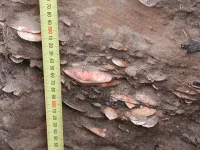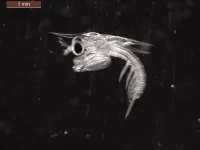(Press-News.org) LAWRENCE -- For thousands of years during the last ice age, generations of maritime migrants paddled skin boats eastward across shallow ocean waters from Asia to present-day Alaska. They voyaged from island to island and ultimately to shore, surviving on bountiful seaweeds, fish, shellfish, birds and game harvested from coastal and nearshore biomes. Their island-rich route was possible due to a shifting archipelago that stretched almost 900 miles from one continent to the other.
A new study from the University of Kansas in partnership with universities in Bologna and Urbino, Italy, documents the newly named Bering Transitory Archipelago and then points to how, when and where the first Americans may have crossed. The authors' stepping-stones hypothesis depends on scores of islands that emerged during the last ice age as sea level fell when ocean waters were locked in glaciers and later rose when ice sheets melted. The two-part study, just published in the open-access journal Comptes Rendus Geoscience, may answer what writer Fen Montaigne calls "one of the greatest mysteries of our time . . . when humans made the first bold journey to the Americas."
The "stepping-stones" idea hinges on retrospective mapping of sea levels while accounting for isostacy -- deformation of the Earth's crust due to the changing depth and weight of ice and water, reaching its greatest extreme during the Last Glacial Maximum about 20,500 years ago.
"We digitally discovered a geographic feature of considerable size that had never been properly documented in scientific literature," said principal author Jerome Dobson, professor emeritus of geography at KU. "We named it the Bering Transitory Archipelago; it existed from about 30,000 years ago through 8,000 years ago. When we saw it, we immediately thought, 'Wow, maybe that's how the first Americans came across.' And, in fact, everything we've tested seems to bear that out -- it does seem to be true."
For more than a decade, researchers have pondered a mystery within a mystery. Mitochondrial DNA indicates that migrants were isolated somewhere for up to 15,000 years on their way over from Asia to North America. The Beringian Standstill Hypothesis arises from the fact that today Native American DNA is quite different from Asian DNA, a clear indication of genetic drift of such magnitude that it can only have happened over long periods of time in nearly complete isolation from the Asian source population. The Bering Transitory Archipelago provides a suitable refugium with internal connectivity and outward isolation.
Dobson said people crossing the Bering Sea probably didn't have sails but could have been experienced in paddling skin boats like the kayaks and umiaks that Inuits use today.
"They probably traveled in small groups," he said, "either from Asia or islands off the coast of Asia. Some maritime people are known to have existed 27,000 years ago on northern Japanese islands. They probably were maritime people -- not just living on islands, but actually practicing maritime culture, economy and travel."
Dobson recently received the American Geographical Society's Cullum Geographical Medal (the same gold medal that Neil Armstrong won for flying to the moon and Rachel Carson won for writing "Silent Spring"). He named and continuously champions "aquaterra" -- all lands that were exposed and inundated repeatedly during the Late Pleistocene ice ages -- thus creating a zone of archeological promise scattered offshore from all coastal regions around the globe.
Recently, Dobson and co-authors Giorgio Spada of the University of Bologna and Gaia Galassi of Urbino University "Carlo Bo" applied an improved Glacial Isostatic Adjustment model to nine global choke points, meaning isthmuses and straits that have funneled transport and trade throughout history. Significant human migrations are known to have occurred across some of them, including "Beringia"-- all portions of the Bering Sea that were exposed before, during and after the Last Glacial Maximum.
"These Italian ocean scientists read my 'Aquaterra' paper and took it upon themselves to refine the boundaries of aquaterra for the whole world at coarse resolution and for Beringia itself at fine resolution," Dobson said. "Later we agreed to join forces and tackle those nine global choke points. At the end of that study, we suddenly spotted these islands in the Bering Sea, and that became our focus. This had an immediate potential because it could be a real game-changer in terms of all sciences understanding how migration worked in the past. We found startling results in certain other choke points and have begun analyzing them as well."
In Beringia, the three investigators contend, this action produced a "conveyor belt" of islands that rose from the sea and fell back again, pushing bands of people eastward. "The first islands to appear were just off the coast of Siberia," the KU researcher said. "Then islands appeared ever eastward. Most likely migrants kept expanding eastward, too, generally to islands within view and an easy paddle away."
By 10,500 years ago, when the Bering Strait itself first appeared, almost all islands in the west had submerged. Only three islands remained, and paddling distances had increased accordingly. Thus, occupants were forced to evacuate, and they faced a clear choice: return to Asia, which they knew to be populated and may even have left due to population pressures and resource constraints, or paddle east to less known territory, perhaps less populated islands with ample resources.
To fully confirm the idea set forth in the new paper, Dobson said researchers from many fields will need to collaborate as one geographer and two ocean scientists have done here.
"We ourselves are at a stage where we definitely need underwater confirmation," he said. "No doubt underwater archaeologists by title will prevail in that quest, but other disciplines, specialties and fields are essential. Working together plus scouring diverse literature, we presented a fundamentally new physical geography for scientists to contemplate. That should entice every relevant discipline to question conventional theory and explore new ideas regarding how, when and where people came to North America. More broadly, aquaterra can serve as a unifying theme for understanding human migrations, demic expansions, evolutionary biology, culture, settlement and endless other topics."
INFORMATION:
NEW YORK, NY (April 29, 2021)--A new study is drawing the most detailed picture yet of SARS-CoV-2 infection in the lung, revealing mechanisms that result in lethal COVID-19, and may explain long-term complications and show how COVID-19 differs from other infectious diseases.
Led by researchers at Columbia University Vagelos College of Physicians and Surgeons and Herbert Irving Comprehensive Cancer Center, the study found that in patients who died of the infection, COVID-19 unleashed a detrimental trifecta of runaway inflammation, direct destruction and impaired regeneration of lung cells involved in gas exchange, and accelerated lung scarring.
Though the study looked at lungs from patients who had died of the disease, ...
Primary care practitioners often over-estimate the likelihood of a patient having a medical condition based on reported symptoms and laboratory test results. Such overestimations can lead to overdiagnosis and overtreatment, according to a recent study conducted by researchers at the University of Maryland School of Medicine (UMSOM) published in JAMA Internal Medicine.
"A large gap exists between practitioner estimates and scientific estimates of the probability of disease," said study leader Daniel Morgan, MD, a Professor of Epidemiology & Public Health at UMSOM. "Practitioners who overestimate ...
The discovery of ancient kumara pits just north of Dunedin dating back to the 15th century have shone a light on how scientific evidence can complement mātauranga Maori around how and where the taonga were stored hundreds of years ago.
A new study published in the science journal PLOS ONE reports that early Polynesians once stored kumara - American sweet potato - in pits dug into sand dunes at Purākaunui, eastern Otago, less than 30km north of Dunedin. The pits were first discovered in 2001 and are found over 200km south of the currently accepted South Island limit of cooler-climate Māori kumara storage.
These Purākaunui features have the novel form of semi-subterranean, rectangular pits used for the cool seasonal storage ...
The brain possesses a complex architecture of functional networks as its information-processing machinery. Is the brain's network architecture itself a target of disease? If so, which networks are associated with which diseases? What can this tell us about the underlying causes of brain disorders?
Building on the extraordinary progress in neuroscience made over the past 30 years, researchers from The University of Texas Health Science Center at San Antonio (UT Health San Antonio) published a study of 43 brain disorders - both psychiatric and neurologic - and strongly affirmed ...
EUGENE, Ore. -- April 29, 2021 -- An analysis of Twitter activity between March 1 and Aug. 1, 2020, found strong support by U.S. users for wearing face coverings and that a media focus on anti-mask opinions fueled the rhetoric of those opposed, report University of Oregon researchers.
The study, published April 28 in the journal PLOS ONE, initially focused on linguistics, zeroing in on the language associated with hashtags during the study period, which began a month before the Centers for Disease Control and Prevention recommended mask-wearing to protect against COVID-19 infection.
However, to better understand that semantics, which were found to be polarized, angry and emotionally ...
Adult mantis shrimp pack an explosive punch that can split water, but no crustacean emerges fully formed. Minute larvae can undergo six or seven transformations before emerging as fully developed adults and limbs and manoeuvres develop over time. So, when do mantis shrimp larvae acquire the ability to pulverise their dinner and how powerful are the punches that these mini crustaceans pack? 'We knew that larval mantis shrimp have these beautiful appendages; Megan Porter and Eve Robinson at the University of Hawaii had captured normal videos of a couple of strikes a few years ago', says Jacob Harrison from Duke University, USA. So, he packed up ...
Adult heterosexual women and men are often jealous about completely different threats to their relationship. These differences seem to establish themselves far sooner than people need them. The finding surprised researchers at the Norwegian University of Science and Technology (NTNU) who studied the topic.
"You don't really need this jealousy until you need to protect yourself from being deceived," says Professor Leif Edward Ottesen Kennair at NTNU's Department of Psychology.
Romantic jealousy can be experienced as horrible at its worst. But jealousy associated with a partner's infidelity has clearly been ...
More than a quarter of American infants in 2018 had not received common childhood vaccines that protect them from illnesses such as polio, tetanus, measles, mumps and chicken pox, new research from the University of Virginia School of Medicine reveals.
Only 72.8% of infants aged 19-35 months had received the full series of the seven recommended vaccines, falling far short of the federal government's goal of 90%. Those less likely to complete the vaccine series include African-American infants, infants born to mothers with less than a high-school education and infants in families with incomes below the federal poverty line.
The researchers warn that failure to complete the vaccine series leaves children at increased risk of infection, illness and death. It also reduces the herd ...
Human decision-making depends on the flexible processing of complex information, but how the brain may adapt processing to momentary task demands has remained unclear. In a new article published in the journal Nature Communications, researchers from the Max Planck Institute for Human Development have now outlined several crucial neural processes revealing that our brain networks may rapidly and flexibly shift from a rhythmic to a "noisy" state when the need to process information increases.
Driving a car, deliberating over different financial options, or even pondering different life paths requires us to process an overwhelming amount of information. But not all decisions pose equal demands. In some situations, decisions are easier because we already know which ...
People with diabetes are at increased risk of developing a severe course of COVID-19 compared to people without diabetes. The question to be answered is whether all people with diabetes have an increased risk of severe COVID-19, or whether specific risk factors can also be identified within this group. A new study by DZD researchers has now focused precisely on this question and gained relevant insights.
The COVID-19 pandemic poses unprecedented challenges to science and the health sector. While in some people with a SARS-CoV-2 infection the disease is hardly noticeable, in others ...


